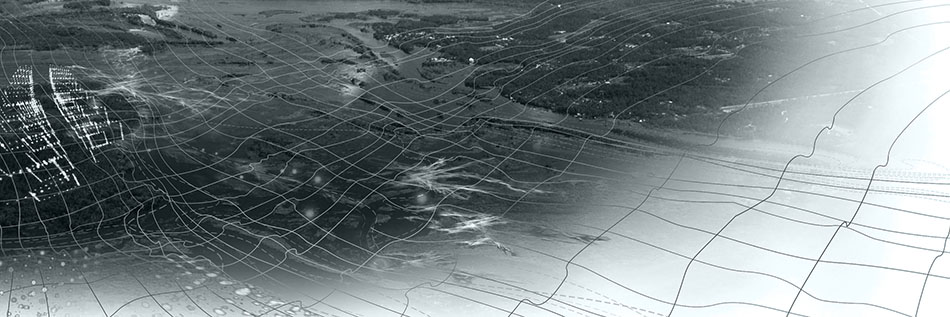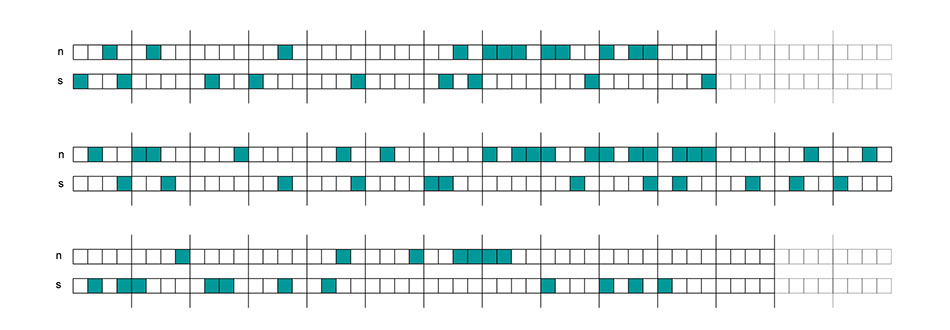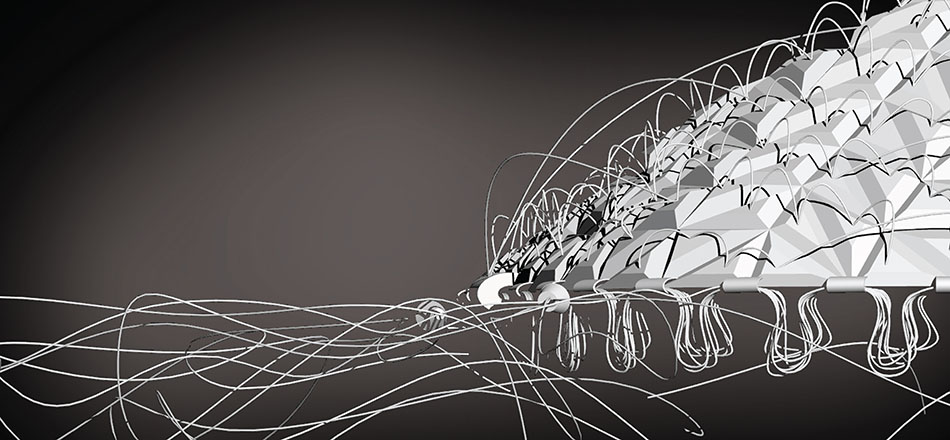Reactscape device:space
Project 2.0 . Strategy and Implementation
Overview
The remaining portion of the semester will be consumed with the evolution of the site prototype, creating an adaptive management strategy, and the refinement of an implementation strategy. Each of the aforementioned elements will develop concurrently and inform one another to create a comprehensive proposal for a synthetic ecology within West Oakland.
The design and conceptualization of a synthetic ecology will involve the development of rules for manipulation that respond to the overall performance of the ecology’s capacities. In order to effectively monitor the performance capacity and effectively use project management software, measurements will need to be taken in real-time that reflect both the agency of human and non-human actors within the landscape quantifying the effectiveness of the network and the materials that define it. The ability to measure performance of a synthetic ecology using software for project management in construction industry requires a unique definition for the ecological fitness that is specific to the site. This definition of fitness is not inherent within systems and must be defined within the proposals.
The quantification and manipulation of synthetic ecological dynamics can be driven by utilizing concepts of resilience, adaptive cycles, and relationships across scales. It will be necessary to address the following questions:
-
How does the proposal address adaptation as a method for system evolution and as an agent of change?
-
What role does autonomy play in the creation of intelligent systems and behaviors (software, hardware, wetware)?
-
How does computational iteration (micro-second decision making) play a role in the management, evolution, and expression of the synthetic ecology?
-
What role does resistance and failure play in a designed system?
Evolved Site Prototypes . Site Model
The site prototypes will serve as the lens for accessing, observing, and assessing site phenomena. The evolution of the site prototypes will push for added complexity and the coupling of multiple layers of represented or simulated data. Through a feedback loop between site proposals, data acquisition/construction, and performative tweaks the prototype(s) will become a virtualized site model. This model will be the lens through which the site is interpreted and the testbed for iterative design proposals. The model will be a method of measurement, a datum to measure change or stasis and to define a system’s overall fitness.
The model will address issues of coupling, access, rigor, and projection. The model should couple multiple data streams to explore the effects of multiple phenomena. This coupling will require that relationships are defined and quantified between similar and dissimilar systems. It is important that the model is accessible within the design process. This requires that the model is malleable and hackable either physically or virtually. It is not enough for the model to be a representation of a system, it must be accessible and modifiable. The data and performance of the model will be defendable and rigorous. This does not mean that the model is a 1 to 1 simulation but instead states that the rigor comes from acknowledging the performative qualities of the model. It is necessary to be transparent about the under or over performing nature of the model and taking this weakness as a feature of the representation. The model must be projective, allowing for speculation and inquiry. It is not enough to verify observed site phenomena, instead the model will propose new trajectories and methodologies.
Deliverables: Virtual and Physical Models, Diagrams, Mappings, or other forms of media as appropriate
baseline
- physical model that tests 1-3 site phenomena relevant to the project
- digital model testing 1-3 site phenomena relevant to project
- diagrams explaining site model and testing methodologies
- diagrams highlighting results
- mappings relating the site model to the physical site and/or identifying key relationships
Adaptive Management Strategy
Each proposal will be underpinned by a strategy that defines methods of management that adapt to known or unknown futures. At the base level the strategy must address management of the proposed ecology through temporal and spatial scales within a synthesized site model to develop a passive or active management protocol. The ability to experiment with responsive technologies should directly influence the adaptive management strategy and play a central role in the proposal.
Understanding the role of management within systems of adaptability and change defines the designer’s role as a curator or manipulator of processes. How do responsive technologies play a central role in the monitoring and management of these systems? How does computational iteration (micro-timescales) and autonomy advance concepts of adaptive management?
The studio focus on indeterminate systems relies on unorthodox methods of measurement, implementation of failure, and modes of resistance. The indeterminacy of site systems and networks constructs a future for networks as political ontologies, which place the material significance of networks as a critical indicator to establishing effective protocol; the ability for political control of networks. This methodology of applying protocol to biological networks (protocological control) to aid in political resistance can be paralleled to the necessary methods for adjusting the complex networks that would exist in a synthetic ecology. Small adjustments to protocol, counterprotocols, can be envisioned as a set of design rules, management guidelines, or instructions for landscape manipulation to aid in adaptive management.
Resistance is generally a political term, used to describe tactics for initiating political reform can be understood as a metaphor for small adjustments to the system. The idea of a resistance is especially compelling within the context of designing counterprotocols for ecological systems and networks. Instead of instituting a definite system, the counterprotocol takes advantage of an ecosystem’s adaptive and generative capabilities to excite change by a catalytic resistance. This target of resistance as a stimulus for protocol’s ability to sculpt and inflect allows for small adjustments to effectively manipulate the overall structure of the network over time.
The adaptive management strategy created by each group should build on a range of studio themes that speculate on the behavior of complex networks and ecologies. Moving away from reductionist approaches of stability, certainty, and order, the studio embraces management strategies that promote flexibility, adaptability, and resilience.
Deliverables: Diagrams and Mappings or other forms of media as appropriate
baseline
- diagrams highlighting methods implemented in the adaptive management strategy
- mappings illustrating the effects of the strategy through time
- site scale plans illustrating the effects of the strategy through time
- detail drawings highlighting effects or methods of the strategy (sections, plans, axon)
Implementation
As a method of testing each proposal will conceive of methods of implementation that realize physical or operational landscapes and/or ecologies. The proposal may be an instance or multiple iterations that propose the physical workings of a synthetic ecology. The implementation should spawn from and/or drive the adaptive management scenario. An iterative process should be developed to relate the site prototype/model with successive rounds of testing the implementation schemes.
The implementation should describe the operations, materials, and physical constructions that would take effect within the proposal. This description should be visceral and speak to the range of permanence and impermanence of the interventions. When describing the systems the representation should be rigorous and relational, grounding the proposal within the physical environment. This should employ a combination of new media tools as well as traditional modes of representation to describe physical scale.
Deliverables: Site Plans, Sections, Physical Prototypes, Digital and Analog Models, Diagrams, and Mappings or other forms of media as appropriate
baseline
- site plans highlighting site layout at multiple scales
- 4-5 sections highlighting site modifications
- physical models at multiple scales highlighting implementation
- digital model highlighting site modifications and rendered views (perspectives)
- diagrams explaining implementation strategy
- prototypes, proof of concept models focusing on implementation of responsive technologies
Milestones
October 21st . Mid-Term Review
Evolved site prototype, adaptive management strategy, and initial implementation methods/prototypes.
Documentation of progress on responsivelandscapes.com
November 26th . Final Studio Review
Evolved site prototype, adaptive management strategy, and implementation strategy/prototypes
December 13th . Documentation Due




